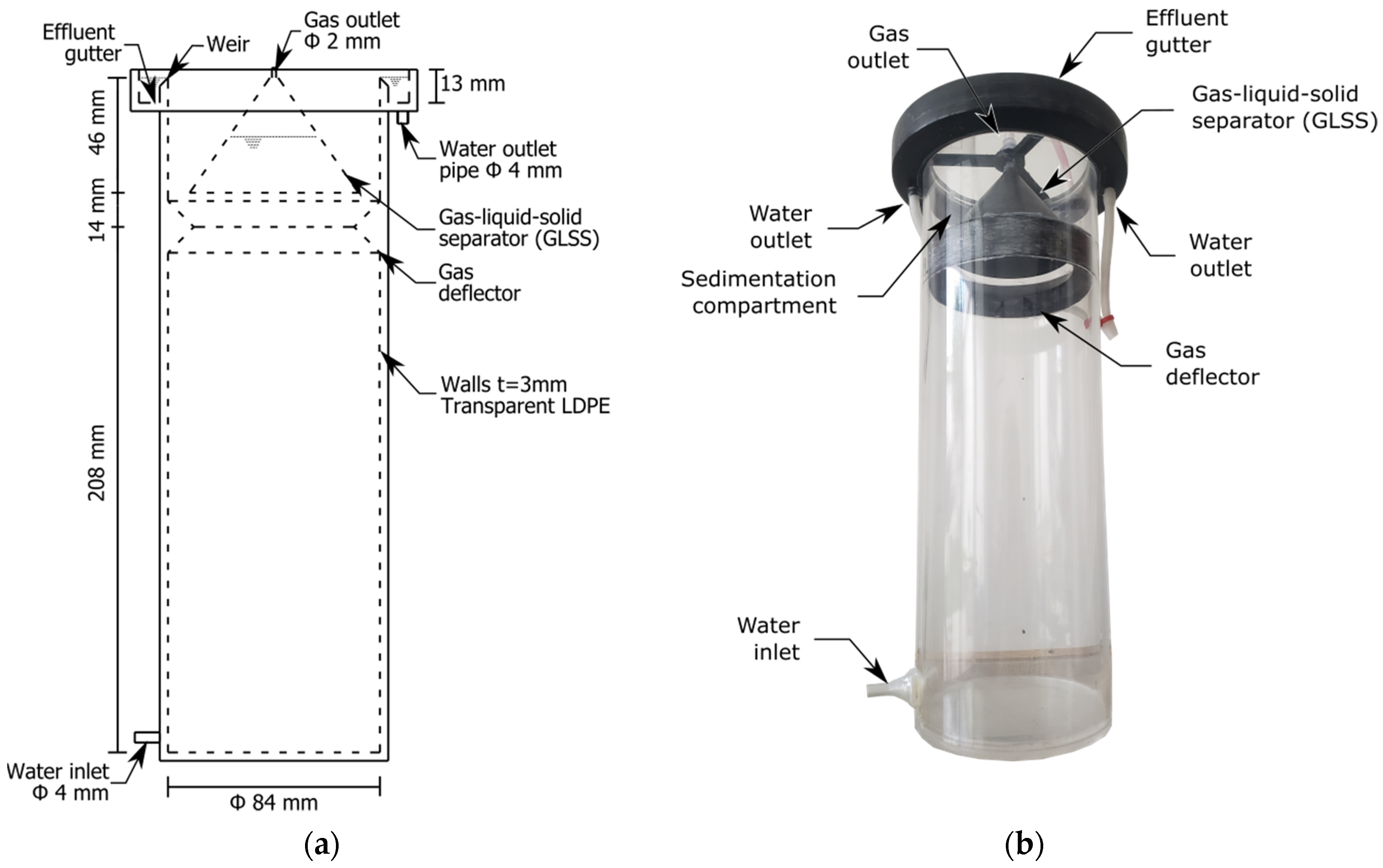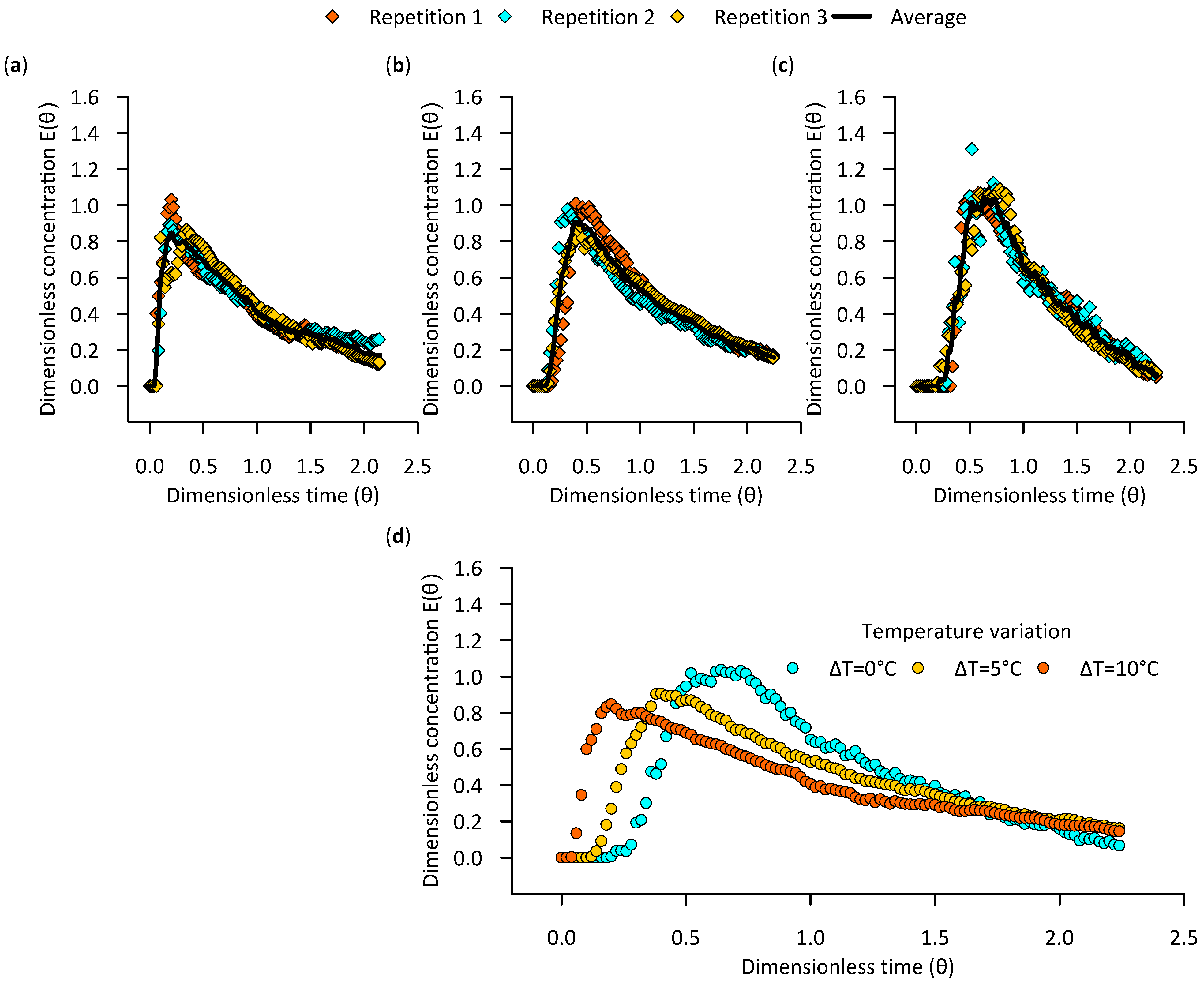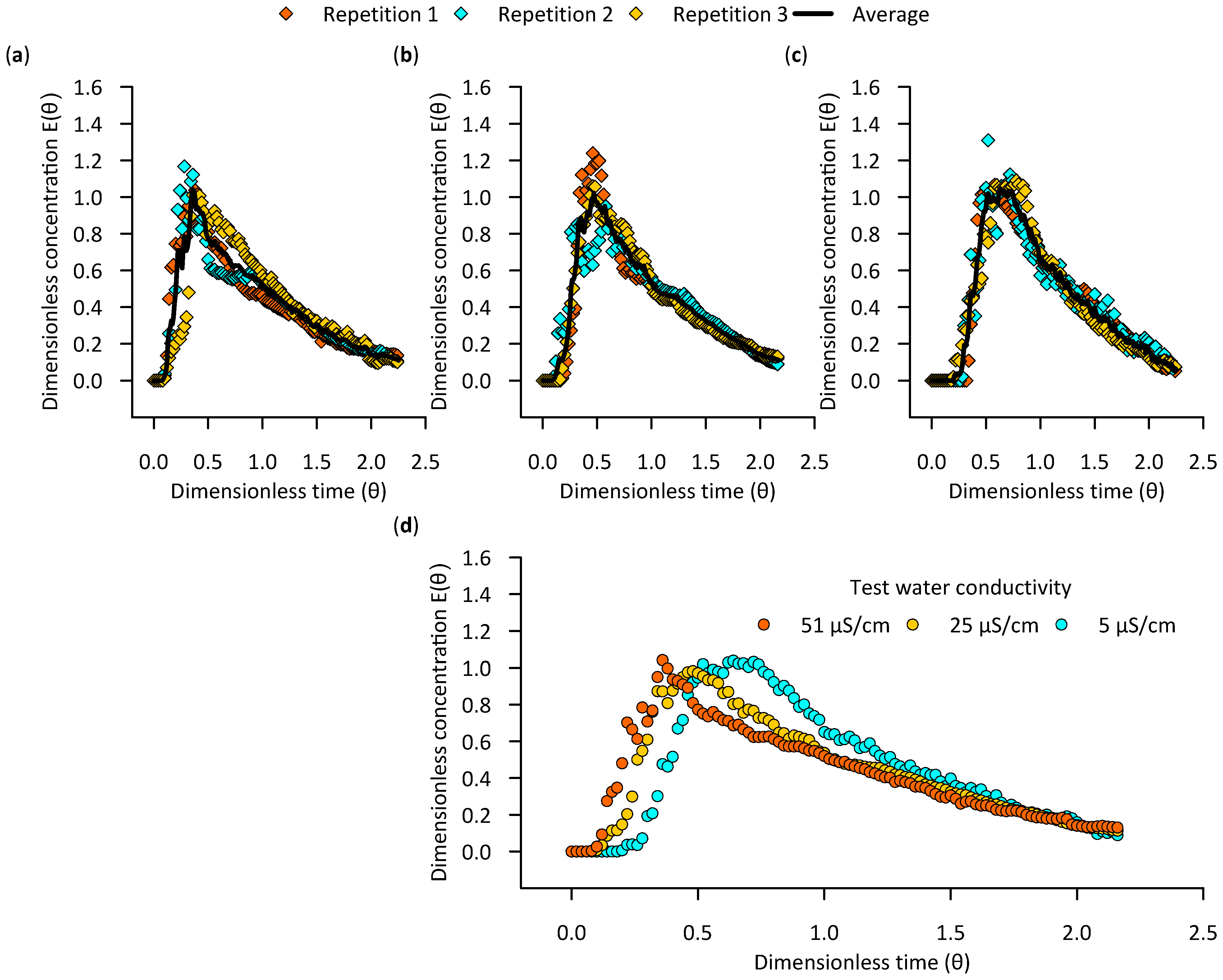Development of an Automated Tracer Testing System for UASB Laboratory-Scale Reactors
Abstract
:1. Introduction
- −
- the tracer should possess low molecular diffusivity,
- −
- the presence of the tracer should not affect the studied flow,
- −
- the tracer should be conservative over time to allow performing mass balances,
- −
- the tracer should not react (or be absorbed) with the reactor walls or by particles in the flow; and
- −
- the tracer must be conveniently measurable.
2. Materials and Methods
2.1. Automated RTD Measurement System
2.2. UASB Reactor
3. Results and Discussion
3.1. Operation of the Automated RTD Measuring System: Problems and Solutions
3.1.1. Flow Stabilization Time
3.1.2. Temperature
3.1.3. Test Water Conductivity
3.1.4. Superficial Tension Effect
3.2. Automated RTD Measurement System Performance and UASB Hydraulic Characterization
4. Conclusions
Author Contributions
Funding
Data Availability Statement
Acknowledgments
Conflicts of Interest
References
- Von Sperling, M. Waste Stabilisation Ponds; Biological Wastewater Treatment Series; IWA Publishing: London, UK, 2007; Volume 3. [Google Scholar]
- Jenkins, D.; Wanner, J. Activated Sludge-100 Years and Counting; IWA Publishing: London, UK, 2014. [Google Scholar]
- Gorzalski, A.S.; Harrington, G.W.; Coronell, O. Modeling Water Treatment Reactor Hydraulics Using Reactor Networks. J. AWWA 2018, 110, 13–29. [Google Scholar] [CrossRef] [Green Version]
- Metcalf & Eddy; Tchobanoglous, G.; Tsuchihashi, R.; Stensel, H.D. Wastewater Engineering: Treatment and Resource Recovery; McGraw-Hill Education: New York, NY, USA, 2013; ISBN 978-0-07-340118-8. [Google Scholar]
- Persson, J.; Somes, N.L.G.; Wong, T.H.F. Hydraulics Efficiency of Constructed Wetlands and Ponds. Water Sci. Technol. 1999, 40, 291–300. [Google Scholar] [CrossRef]
- Jiang, J.; Wu, J.; Zhang, J.; Poncin, S.; Li, H.Z. Multiscale Hydrodynamic Investigation to Intensify the Biogas Production in Upflow Anaerobic Reactors. Bioresour. Technol. 2014, 155, 1–7. [Google Scholar] [CrossRef] [PubMed]
- Wang, H.; Lee, S.; Hassan, Y.A. Particle Image Velocimetry Measurements of the Flow in the Converging Region of Two Parallel Jets. Nucl. Eng. Des. 2016, 306, 89–97. [Google Scholar] [CrossRef] [Green Version]
- Chen, J.; Kemoun, A.; Al-Dahhan, M.H.; Duduković, M.P.; Lee, D.J.; Fan, L.-S. Comparative Hydrodynamics Study in a Bubble Column Using Computer-Automated Radioactive Particle Tracking (CARPT)/Computed Tomography (CT) and Particle Image Velocimetry (PIV). Chem. Eng. Sci. 1999, 54, 2199–2207. [Google Scholar] [CrossRef]
- Shahi, S.; Kuru, E. An Experimental Investigation of Settling Velocity of Natural Sands in Water Using Particle Image Shadowgraph. Powder Technol. 2015, 281, 184–192. [Google Scholar] [CrossRef]
- Fiedler, H.; Nottmeyer, K.; Wegener, P.P.; Raghu, S. Schlieren Photography of Water Flow. Exp. Fluids 1985, 3, 145–151. [Google Scholar] [CrossRef]
- Tsai, D.D.-W.; Ramaraj, R.; Chen, P.H. A Method of Short-Circuiting Comparison. Water Resour. Manag. 2012, 26, 2689–2702. [Google Scholar] [CrossRef]
- Peña, M.R.; Mara, D.D.; Avella, G.P. Dispersion and Treatment Performance Analysis of an UASB Reactor under Different Hydraulic Loading Rates. Water Res. 2006, 40, 445–452. [Google Scholar] [CrossRef] [PubMed]
- Pérez Montiel, J.I.; Galindo Montero, A.; Ramírez-Muñoz, J. Comparison of Different Methods for Evaluating the Hydraulics of a Pilot-Scale Upflow Anaerobic Sludge Blanket Reactor. Environ. Process. 2019, 6, 25–41. [Google Scholar] [CrossRef]
- Yang, J.; Yang, Y.; Ji, X.; Chen, Y.; Guo, J.; Fang, F. Three-Dimensional Modeling of Hydrodynamics and Biokinetics in EGSB Reactor. J. Chem. 2015. [Google Scholar] [CrossRef] [Green Version]
- Passos, R.G.; Dias, D.F.C.; Matos, M.P.; von Sperling, M. Sodium Chloride as a Tracer for Hydrodynamic Characterization of a Shallow Maturation Pond. Water Pract. Technol. 2018, 13, 30–38. [Google Scholar] [CrossRef]
- De Carvalho, K.Q.; Salgado, M.T.; Passig, F.H.; Pires, E.C. Hydrodynamic Evaluation of a UASB Reactor Submitted to Cyclical Flowrate Variation. Eng. Sanit. E Ambient. 2008, 13, 226–235. [Google Scholar] [CrossRef] [Green Version]
- Alvarado, A.; Vesvikar, M.; Cisneros, J.F.; Maere, T.; Goethals, P.; Nopens, I. CFD Study to Determine the Optimal Configuration of Aerators in a Full-Scale Waste Stabilization Pond. Water Res. 2013, 47, 4528–4537. [Google Scholar] [CrossRef] [PubMed]
- Morgan-Sagastume, J.M.; Jiménez, B.; Noyola, A. Tracer Studies in a Laboratory and Pilot Scale UASB Reactor. Environ. Technol. 1997, 18, 817–825. [Google Scholar] [CrossRef]
- Newell, B.; Bailey, J.; Islam, A.; Hopkins, L.; Lant, P. Characterising Bioreactor Mixing with Residence Time Distribution (RTD) Tests. Water Sci. Technol. 1998, 37, 43–47. [Google Scholar] [CrossRef]
- Yu, J.; Gao, X.; Lu, L.; Xu, Y.; Li, C.; Li, T.; Rogers, W.A. Validation of a Filtered Drag Model for Solid Residence Time Distribution (RTD) Prediction in a Pilot-Scale FCC Riser. Powder Technol. 2021, 378, 339–347. [Google Scholar] [CrossRef]
- Lettinga, G.; van Velsen, A.F.M.; Hobma, S.W.; de Zeeuw, W.; Klapwijk, A. Use of the Upflow Sludge Blanket (USB) Reactor Concept for Biological Wastewater Treatment, Especially for Anaerobic Treatment. Biotechnol. Bioeng. 1980, 22, 699–734. [Google Scholar] [CrossRef]
- Latif, M.A.; Ghufran, R.; Wahid, Z.A.; Ahmad, A. Integrated Application of Upflow Anaerobic Sludge Blanket Reactor for the Treatment of Wastewaters. Water Res. 2011, 45, 4683–4699. [Google Scholar] [CrossRef] [PubMed]
- UN DESA. Transforming Our World: The 2030 Agenda for Sustainable Development; UN DESA: New York, NY, USA, 2016. [Google Scholar]
- Batstone, D.J.; Hernandez, J.L.A.; Schmidt, J.E. Hydraulics of Laboratory and Full-Scale Upflow Anaerobic Sludge Blanket (UASB) Reactors. Biotechnol. Bioeng. 2005, 91, 387–391. [Google Scholar] [CrossRef] [PubMed]
- Versteeg, H.K.; Malalasekera, W. An Introduction to Computational Fluid Dynamics: The Finite Volume Method; Pearson Education: London, UK, 2007. [Google Scholar]
- Fogler, H.S. Essentials of Chemical Reaction Engineering: Essenti Chemica Reactio Engi; Pearson Education: London, UK, 2010; ISBN 978-0-13-231717-7. [Google Scholar]
- ASTM International. ASTM D1193-06(2018) Standard Specification for Reagent Water; ASTM International: West Conshohocken, PA, USA, 2018; 6p. [Google Scholar]
- Levenspiel, O. Chemical Reaction Engineering, 3rd ed.; Wiley: New York, NY, USA, 1998; ISBN 978-0-471-25424-9. [Google Scholar]









Publisher’s Note: MDPI stays neutral with regard to jurisdictional claims in published maps and institutional affiliations. |
© 2021 by the authors. Licensee MDPI, Basel, Switzerland. This article is an open access article distributed under the terms and conditions of the Creative Commons Attribution (CC BY) license (https://creativecommons.org/licenses/by/4.0/).
Share and Cite
Cisneros, J.F.; Pelaez-Samaniego, M.R.; Pinos, V.; Nopens, I.; Alvarado, A. Development of an Automated Tracer Testing System for UASB Laboratory-Scale Reactors. Water 2021, 13, 1821. https://doi.org/10.3390/w13131821
Cisneros JF, Pelaez-Samaniego MR, Pinos V, Nopens I, Alvarado A. Development of an Automated Tracer Testing System for UASB Laboratory-Scale Reactors. Water. 2021; 13(13):1821. https://doi.org/10.3390/w13131821
Chicago/Turabian StyleCisneros, Juan F., Manuel Raul Pelaez-Samaniego, Verónica Pinos, Ingmar Nopens, and Andrés Alvarado. 2021. "Development of an Automated Tracer Testing System for UASB Laboratory-Scale Reactors" Water 13, no. 13: 1821. https://doi.org/10.3390/w13131821
APA StyleCisneros, J. F., Pelaez-Samaniego, M. R., Pinos, V., Nopens, I., & Alvarado, A. (2021). Development of an Automated Tracer Testing System for UASB Laboratory-Scale Reactors. Water, 13(13), 1821. https://doi.org/10.3390/w13131821






